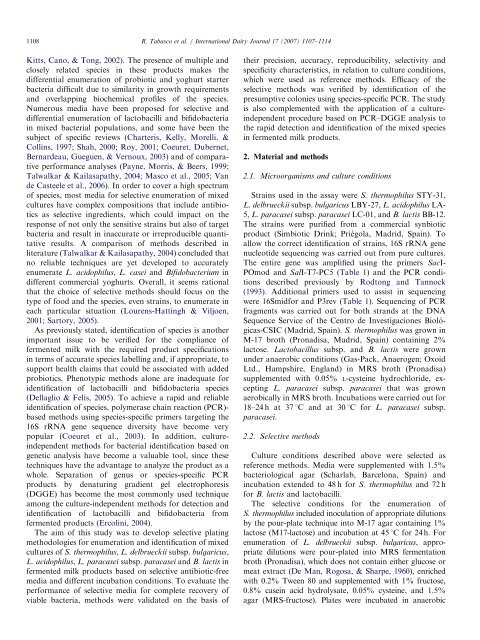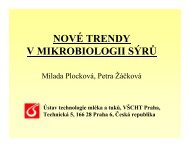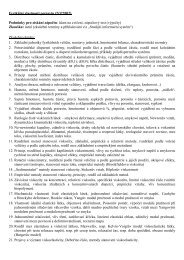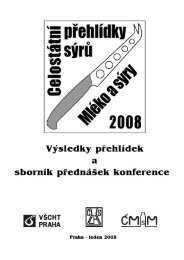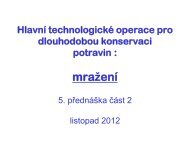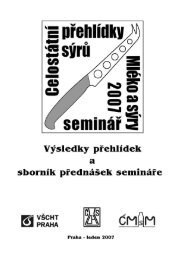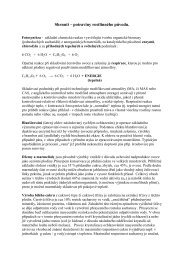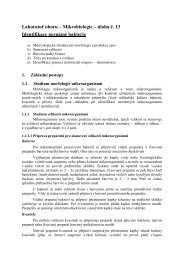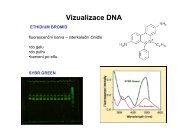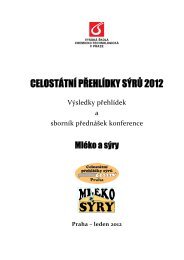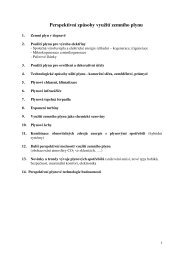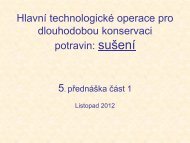Selective enumeration and identification of mixed cultures of ...
Selective enumeration and identification of mixed cultures of ...
Selective enumeration and identification of mixed cultures of ...
Create successful ePaper yourself
Turn your PDF publications into a flip-book with our unique Google optimized e-Paper software.
1108<br />
Kitts, Cano, & Tong, 2002). The presence <strong>of</strong> multiple <strong>and</strong><br />
closely related species in these products makes the<br />
differential <strong>enumeration</strong> <strong>of</strong> probiotic <strong>and</strong> yoghurt starter<br />
bacteria difficult due to similarity in growth requirements<br />
<strong>and</strong> overlapping biochemical pr<strong>of</strong>iles <strong>of</strong> the species.<br />
Numerous media have been proposed for selective <strong>and</strong><br />
differential <strong>enumeration</strong> <strong>of</strong> lactobacilli <strong>and</strong> bifidobacteria<br />
in <strong>mixed</strong> bacterial populations, <strong>and</strong> some have been the<br />
subject <strong>of</strong> specific reviews (Charteris, Kelly, Morelli, &<br />
Collins, 1997; Shah, 2000; Roy, 2001; Coeuret, Dubernet,<br />
Bernardeau, Gueguen, & Vernoux, 2003) <strong>and</strong> <strong>of</strong> comparative<br />
performance analyses (Payne, Morris, & Beers, 1999;<br />
Talwalkar & Kailasapathy, 2004; Masco et al., 2005; Van<br />
de Casteele et al., 2006). In order to cover a high spectrum<br />
<strong>of</strong> species, most media for selective <strong>enumeration</strong> <strong>of</strong> <strong>mixed</strong><br />
<strong>cultures</strong> have complex compositions that include antibiotics<br />
as selective ingredients, which could impact on the<br />
response <strong>of</strong> not only the sensitive strains but also <strong>of</strong> target<br />
bacteria <strong>and</strong> result in inaccurate or irreproducible quantitative<br />
results. A comparison <strong>of</strong> methods described in<br />
literature (Talwalkar & Kailasapathy, 2004) concluded that<br />
no reliable techniques are yet developed to accurately<br />
enumerate L. acidophilus, L. casei <strong>and</strong> Bifidobacterium in<br />
different commercial yoghurts. Overall, it seems rational<br />
that the choice <strong>of</strong> selective methods should focus on the<br />
type <strong>of</strong> food <strong>and</strong> the species, even strains, to enumerate in<br />
each particular situation (Lourens-Hattingh & Viljoen,<br />
2001; Sartory, 2005).<br />
As previously stated, <strong>identification</strong> <strong>of</strong> species is another<br />
important issue to be verified for the compliance <strong>of</strong><br />
fermented milk with the required product specifications<br />
in terms <strong>of</strong> accurate species labelling <strong>and</strong>, if appropriate, to<br />
support health claims that could be associated with added<br />
probiotics. Phenotypic methods alone are inadequate for<br />
<strong>identification</strong> <strong>of</strong> lactobacilli <strong>and</strong> bifidobacteria species<br />
(Dellaglio & Felis, 2005). To achieve a rapid <strong>and</strong> reliable<br />
<strong>identification</strong> <strong>of</strong> species, polymerase chain reaction (PCR)based<br />
methods using species-specific primers targeting the<br />
16S rRNA gene sequence diversity have become very<br />
popular (Coeuret et al., 2003). In addition, cultureindependent<br />
methods for bacterial <strong>identification</strong> based on<br />
genetic analysis have become a valuable tool, since these<br />
techniques have the advantage to analyze the product as a<br />
whole. Separation <strong>of</strong> genus or species-specific PCR<br />
products by denaturing gradient gel electrophoresis<br />
(DGGE) has become the most commonly used technique<br />
among the culture-independent methods for detection <strong>and</strong><br />
<strong>identification</strong> <strong>of</strong> lactobacilli <strong>and</strong> bifidobacteria from<br />
fermented products (Ercolini, 2004).<br />
The aim <strong>of</strong> this study was to develop selective plating<br />
methodologies for <strong>enumeration</strong> <strong>and</strong> <strong>identification</strong> <strong>of</strong> <strong>mixed</strong><br />
<strong>cultures</strong> <strong>of</strong> S. thermophilus, L. delbrueckii subsp. bulgaricus,<br />
L. acidophilus, L. paracasei subsp. paracasei <strong>and</strong> B. lactis in<br />
fermented milk products based on selective antibiotic-free<br />
media <strong>and</strong> different incubation conditions. To evaluate the<br />
performance <strong>of</strong> selective media for complete recovery <strong>of</strong><br />
viable bacteria, methods were validated on the basis <strong>of</strong><br />
ARTICLE IN PRESS<br />
R. Tabasco et al. / International Dairy Journal 17 (2007) 1107–1114<br />
their precision, accuracy, reproducibility, selectivity <strong>and</strong><br />
specificity characteristics, in relation to culture conditions,<br />
which were used as reference methods. Efficacy <strong>of</strong> the<br />
selective methods was verified by <strong>identification</strong> <strong>of</strong> the<br />
presumptive colonies using species-specific PCR. The study<br />
is also complemented with the application <strong>of</strong> a cultureindependent<br />
procedure based on PCR–DGGE analysis to<br />
the rapid detection <strong>and</strong> <strong>identification</strong> <strong>of</strong> the <strong>mixed</strong> species<br />
in fermented milk products.<br />
2. Material <strong>and</strong> methods<br />
2.1. Microorganisms <strong>and</strong> culture conditions<br />
Strains used in the assay were S. thermophilus STY-31,<br />
L. delbrueckii subsp. bulgaricus LBY-27, L. acidophilus LA-<br />
5, L. paracasei subsp. paracasei LC-01, <strong>and</strong> B. lactis BB-12.<br />
The strains were purified from a commercial synbiotic<br />
product (Simbiotic Drink; Prie´gola, Madrid, Spain). To<br />
allow the correct <strong>identification</strong> <strong>of</strong> strains, 16S rRNA gene<br />
nucleotide sequencing was carried out from pure <strong>cultures</strong>.<br />
The entire gene was amplified using the primers SacI-<br />
POmod <strong>and</strong> SalI-T7-PC5 (Table 1) <strong>and</strong> the PCR conditions<br />
described previously by Rodtong <strong>and</strong> Tannock<br />
(1993). Additional primers used to assist in sequencing<br />
were 16Smidfor <strong>and</strong> P3rev (Table 1). Sequencing <strong>of</strong> PCR<br />
fragments was carried out for both str<strong>and</strong>s at the DNA<br />
Sequence Service <strong>of</strong> the Centro de Investigaciones Biolo´gicas-CSIC<br />
(Madrid, Spain). S. thermophilus was grown in<br />
M-17 broth (Pronadisa, Madrid, Spain) containing 2%<br />
lactose. Lactobacillus subsp. <strong>and</strong> B. lactis were grown<br />
under anaerobic conditions (Gas-Pack, Anaerogen; Oxoid<br />
Ltd., Hampshire, Engl<strong>and</strong>) in MRS broth (Pronadisa)<br />
supplemented with 0.05% L-cysteine hydrochloride, excepting<br />
L. paracasei subsp. paracasei that was grown<br />
aerobically in MRS broth. Incubations were carried out for<br />
18–24 h at 37 1C <strong>and</strong> at 30 1C for L. paracasei subsp.<br />
paracasei.<br />
2.2. <strong>Selective</strong> methods<br />
Culture conditions described above were selected as<br />
reference methods. Media were supplemented with 1.5%<br />
bacteriological agar (Scharlab, Barcelona, Spain) <strong>and</strong><br />
incubation extended to 48 h for S. thermophilus <strong>and</strong> 72 h<br />
for B. lactis <strong>and</strong> lactobacilli.<br />
The selective conditions for the <strong>enumeration</strong> <strong>of</strong><br />
S. thermophilus included inoculation <strong>of</strong> appropriate dilutions<br />
by the pour-plate technique into M-17 agar containing 1%<br />
lactose (M17-lactose) <strong>and</strong> incubation at 45 1C for 24 h. For<br />
<strong>enumeration</strong> <strong>of</strong> L. delbrueckii subsp. bulgaricus, appropriate<br />
dilutions were pour-plated into MRS fermentation<br />
broth (Pronadisa), which does not contain either glucose or<br />
meat extract (De Man, Rogosa, & Sharpe, 1960), enriched<br />
with 0.2% Tween 80 <strong>and</strong> supplemented with 1% fructose,<br />
0.8% casein acid hydrolysate, 0.05% cysteine, <strong>and</strong> 1.5%<br />
agar (MRS-fructose). Plates were incubated in anaerobic


